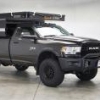It is a little bit counter intuitive, but one of the main reasons to install a DC-DC charger is to overcome wire losses that limit charging to the battery.
In terms of the cabling, I’m simply saying to get thick and short cable INTO the BTB as the BTB can be quite voltage sensitive and might shut off if it’s not getting enough input. If the cable run is going to be longer than 4m away or you want to play it safe, I’d be looking at, minimally, 6 AWG and preferably 4 AWG with a 30 amp BTB. Limiting wire size isn't my preference, but it is an acceptable alternative for some people.
Rich


















